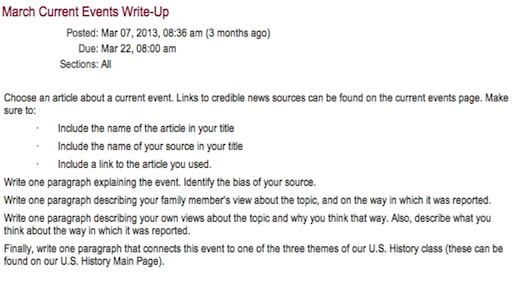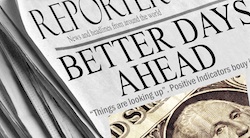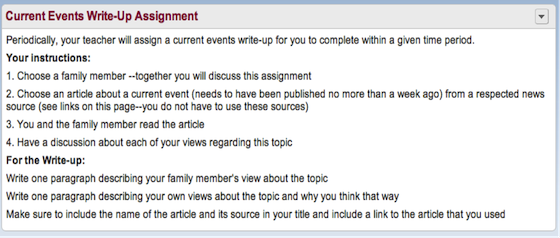Teaching Current Events
A MiddleWeb Blog
by Jody Passanisi & Shara Peters
As social studies teachers, we are responsible for ensuring that our students have proper exposure to current events. However, let’s be realistic: we have a curriculum to teach. And there is already not enough time to teach it. And we are held to that curriculum by administrators, state standards, standardized testing, and — last but not least — our own desire to do justice to our subject.
Obviously, sometimes current events need to be addressed in class, especially if they relate directly to the curriculum, or if they relate to a catastrophe that needs to be addressed for the emotional well-being of the students. These things must be addressed on an informal basis, but we try to bring current events in as a formal assignment as well.
So, our framing question for this blog post is: What are some techniques social studies teachers use to incorporate current events into their classrooms?
Blending the past and present
Some might argue that talking about the past has lesser value if it is not in some way tied to, and made relevant by, the present. It has taken some trial and error for us to come up with a way to address the present in a class about the past, but we have made an attempt to formally incorporate current events on a semi-regular basis.
Our solution to this has been an assignment that has four components. To prevent this assignment from taking away from our class time, it is completed at home (we just make sure to lighten our usual homework load during this time). This assignment is designed for our 8th grade students, but can be broken down and adjusted for younger grades.
Part One: Article Choice and Synopsis (All grades*)

Depending on your students, it may be prudent to create parameters for the type of event the students choose. One difficulty we often ran into with this assignment was students choosing an event that wasn’t really discussion worthy. For example, students are often drawn to articles about sports. While some articles about sports can be very meaningful, especially those about walk-outs, concussions, ethical behaviors, etc., if a student chooses an article that focuses on simple score reporting, there isn’t much substance there to delve into.
*These are just suggestions for grade level and developmental appropriateness: you know your classroom and students best.
Part Two: Different Perspectives (Fourth grade and up)
Our goal for Part Two is for the students to realize that people can have different opinions about events. They are asked to first write about their own opinions about the event– do they think it’s good? bad? fair? ethical? In the middle grades, students are just beginning to realize that they can have different opinions than others. This part of the assignment encourages evaluation and the exploration of their own feelings and opinions.

We are always looking for a way to bring the conversations and content of the classroom home. This assignment has the students collaborate together with the people closest to them. This kind of bridging can be beneficial for teachers, students, and families. It also helps the critical thinking and evaluative aspect of the assignment; students may begin a discussion with their families about differing opinions on the same topic.
Part 3: Bias Identification (Sixth grade and up)
An overarching goal of our eighth grade curriculum is for students to be able to discern the bias of a source. While this may be more challenging for sixth graders, it can be scaffolded in such a way that teachers can attempt to do this earlier than eighth grade.
After identifying their own opinions and discussing their parents’ opinions, we ask students in Part Three to examine what the opinion of the writer of the article might have been. This skill is a challenging one to develop just for this activity, and may require some prior scaffolding — though it is the kind of critical thinking that the 21st century classroom will require, and is worth the time investment.
Some ways we teach students to discern bias are to examine the adjectives that stand out — what kind of story are those adjectives telling? Are they positive or negative? Does the article tell both sides of a story equally? Which side gets more attention? Where is the article from and does that site have a usual bias? Did the author persuade you in some way? These kinds of questions can help prompt students to be more aware that everything they read will have some kind of perspective — both history texts and articles written about current events.
Part 4: Connection to a Course Theme (Eighth grade)
Connecting the current events to the study of history in the classroom can help bridge that gap between study and reality, between the present and the past. Each of our individual units contains an enduring understanding (Understanding by Design), but our whole curriculum is connected by three course themes:
The United States maintains a balance between opposing groups/process.
- The idea of America has been associated with the ideals of freedom, equality, and opportunity; the ideals do not always reflect reality.
- The use, disuse, and misuse of new technologies are crucial in shaping the events in a country’s history.
In Part Four, students are instructed to choose one of the class themes listed above and connect it to the current event they studied. This is a challenging request, and is hard for children who struggle with abstract thinking, so this portion of the assignment is assessed in a differentiated manner. Students naturally bring up examples of content from class when connecting their event to a course theme, but that is not a requirement of the assignment. The point of this is not to further assess their understanding of, say, the Revolutionary War, but is instead to see how they have incorporated course themes into the way they look at the world.
Timing the assignment
We scaffolded this assignment so that by the end of the year students were writing all four parts of the assignment; the first parts can be done at the beginning of the year, and by the end of the year students will have the skills and ability to be able to reflect on parts three and four. We often allowed two weeks for this assignment, which is enough time for the students to find an appropriate article and discuss it with a family member. Scheduling is always complicated so the more time that is allotted, the more likely the conversation between the students and family member will be meaningful.
Here is the version of the assignment that our eighth graders see at the beginning of the year:
By the end of the year, the assignment looks like this:








































I like that this is an ongoing year-long project with scaffolding built in. I teach Ancient History and am going to investigate how to connect it to our themes of civilizations. Any suggestions to help me get started would be very much appreciated!
Can you clarify what you mean in the directions when you ask the students to comment on the way the information or family member’s opinion was reported? Thank you for sharing! :)
Thanks for reading and commenting. For Ancient History it would seem like the easiest way to have students relate current events to course curriculum would be thematic/conceptual. You could ask students to tie an idea or concept in the article they read to a course concept: religion, agriculture, economy, etc. They could compare and contrast, or simply explain how the current event relates to the concept they’ve studied.
Students are meant to report on their family member’s view about the topic as well as the family member’s view on the way the topic was reported. Thank you for catching that language ambiguity–will reword for next year.
Thank you so much for this article. I am looking for a better way to integrate current events into the curriculum and I think this would be really great. However, I teach many students whose parents just do not engage in the students’ classroom activities. How do I get my students and their families to really embrace this assignment?